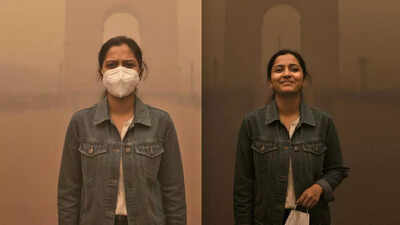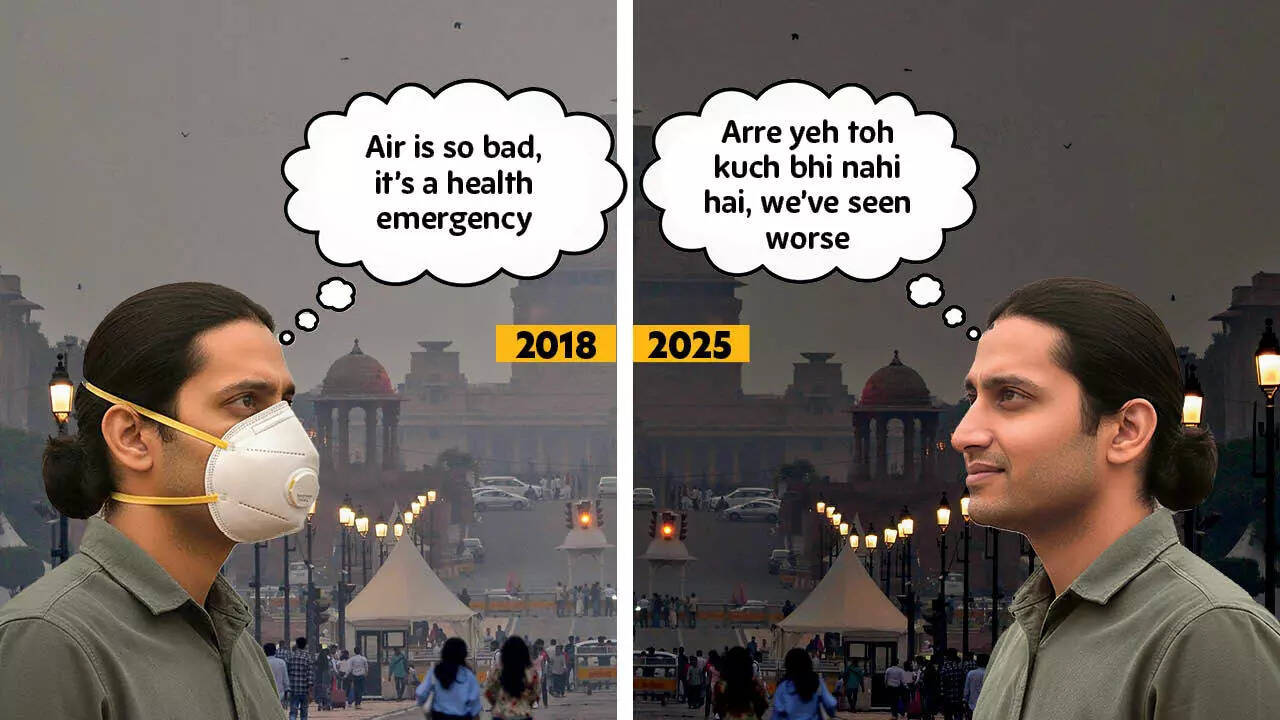ARTICLE AD BOX

The mask, once a familiar post-Diwali accessory, has all but vanished
It’s that time of the year again when conversations in NCR turn, predictably, to air quality and the haze that hangs over the city. As per reports, Delhi’s air continued to be in the “very poor” category on Tuesday, with the AQI above 300.
Yet, on the streets, life moves on as usual – masks off, routines unchanged.“AQI 300, 400? We’ve seen worse,” many shrug. The mask, once a familiar post-Diwali accessory, has all but vanished. Whether it’s the smog, construction dust, or morning jogs through grey air, nothing seems to prompt residents to cover up anymore. From the casual acceptance of “live with it” and “what doesn’t kill you makes you stronger” to the misplaced confidence that “pollution only affects sensitive groups,” Delhi’s attitude toward toxic air has hardened into apathy.
Fatigue, misinformation, and sheer convenience have now outweighed preventive caution.

Attend any public gathering, and you’ll see only a handful of people wearing masks
Where are the masks? Attend any public gathering, and you’ll see only a handful of people wearing masks. “Are you sick?” is the usual question for anyone in a mask. “One of the major reasons why people avoid masks despite visible smog is complacency and desensitisation.Many NCR residents have lived through years of poor air quality and have gradually adapted to it as a ‘normal’ seasonal occurrence,” points out Dr Neetu Jain, Senior Consultant, Pulmonology, Critical Care and Sleep Medicine, PSRI Hospital.
She continues, “There’s also a false sense of comfort after the pandemic ended – people associate mask-wearing with illness and restrictions rather than self-protection. In addition, some find masks uncomfortable, especially during long commutes or outdoor work, and underestimate the actual health impact of air pollution.
The combination of fatigue, misinformation, and convenience often outweighs preventive action.”Masks have become a representation of the pandemic for most people rather than a means of protection from pollution. “Many see wearing a mask only as a safeguard against infection and don’t realise that N95s can also filter dangerous pollutants like PM2.5, which are equally damaging to long-term health,” explains Dr Pankaj Chhabra, Clinical Director, Pulmonology, Respiratory and Sleep Medicine, Marengo Asia Hospitals, Faridabad.

“After years of recurring smog and minimal visible improvement in air quality, many citizens feel helpless, or resigned"
‘WHY ARE THERE NO ADVISORIES IN SCHOOLS FOR MASKS?’Questioning the lack of advisories, Jai Dhar Gupta, clean air activist and entrepreneur, says, “We are trying to hide everything – whatever is going on with these monitoring stations not working, turning them off when they reach severe levels, spraying with smog guns – the entire effort is to hide the issue, not to reduce air pollution or protect citizens. Nobody is calling it the public health emergency that this is, and that is the problem.
The AQI is above 300 and it is crazy that people are not wearing a mask. There was some mask fatigue after COVID; I am a huge advocate of masks, yet I was also fatigued. But still, I don’t understand why are there are no advisories in schools for masks?” He rues that “environmentalists like me have lost hope ki kuch hoga .” “We don’t think hamare lifetime mein kuch hoga . Because year after year, it is the same problem. We have normalised an AQI of 400.
Things we get to hear is that what is not killing you is making you stronger – but it is killing you,” stresses Gupta.Mask and pollution fatigue is realFrom COVID to chronic smog seasons, the fatigue of masks and pollution is real, experts note. “After years of recurring smog and minimal visible improvement in air quality, many citizens feel helpless, or resigned. People have learned to ‘live with it’ rather than actively protect themselves. This psychological exhaustion reduces motivation to take preventive steps like wearing masks or using air purifiers.
It’s crucial to rebuild awareness by communicating the direct, everyday health impacts of pollution – not just distant or abstract risks.
Education and community-driven awareness campaigns can help re-engage public attention and public attention and responsibility,” shares Dr Neetu Jain.Pollution myths that persist‘MASKS ARE FOR PREVENTING INFECTIONS, NOT POLLUTION’: “For most people, masks have become symbolic of the pandemic rather than a protective health measure.
During COVID, mask-wearing was enforced by necessity, not by habit. After restrictions were lifted, people wanted to ‘move on’ and associate mask removal with normalcy and freedom. Unfortunately, this psychological link has overshadowed the importance of masks for pollution control.
Many don’t realise that N95 or equivalent masks are designed primarily to filter particulate matter which is exactly what Delhi’s polluted air contains in dangerous concentrations,” advises Dr Neetu Jain.‘POLLUTION ONLY AFFECTS THE ELDERLY OR SICK’Another common myth is that pollution only affects the elderly or those already sick. “Many people also think that staying inside in a clean house means you are completely protected from pollution, or that pollution only affects your lungs. The truth is that toxic air affects your heart, brain, immunity, and even the health of your pregnancy, no matter your age or whether you are exposed only temporarily,” informs Dr Pankaj Chhabra.What you can do now Start with wearing a well-fitted N95 mask. Dr Harish Verma, Associate Director, Pulmonary Medicine & Critical Care, Sharda Care – HealthCity, Greater Noida, advises, “From a medical standpoint, N95 or equivalent masks remain highly effective in filtering out fine particulate matter (PM2.5 and PM10), significantly reducing inhalation of harmful pollutants. However, consistent usage is key. During periods of high pollution, citizens especially children, the elderly, pregnant women, and those with respiratory or cardiac conditions should avoid outdoor activities during early mornings and late evenings, keep windows closed, use air purifiers indoors, stay hydrated, and include antioxidant-rich foods in their diet.
Schools and workplaces should also take responsibility by modifying outdoor schedules and ensuring clean indoor air.”

 5 days ago
12
5 days ago
12









 English (US) ·
English (US) ·